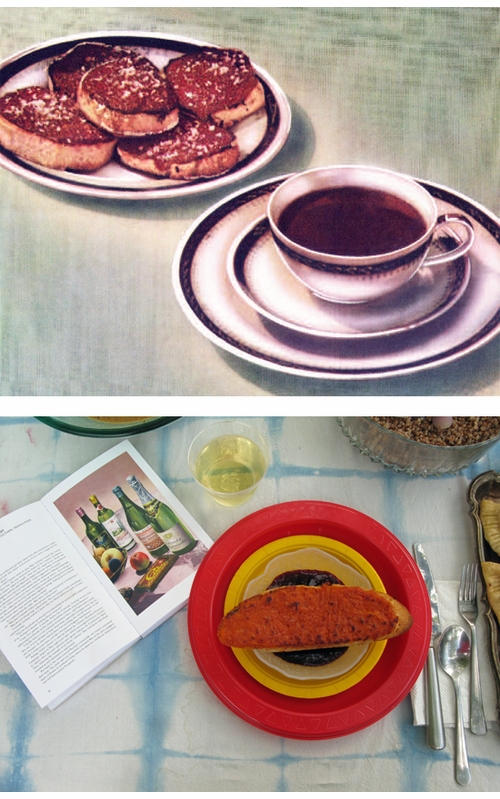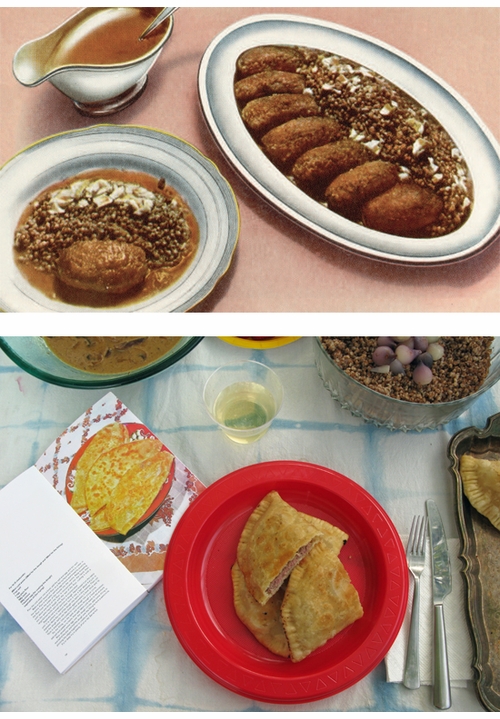| RECENT POSTS DATE 8/20/2024 DATE 4/30/2024 DATE 4/30/2024 DATE 4/25/2024 DATE 4/25/2024 DATE 4/24/2024 DATE 4/21/2024 DATE 4/18/2024 DATE 4/18/2024 DATE 4/14/2024 DATE 4/13/2024 DATE 4/13/2024 DATE 4/12/2024
| | | ALLIE PISARRO-GRANT | DATE 7/19/2017Many of us creative types are familiar with the London publishing house FUEL through their Russian Criminal Tattoo Archive series—beloved by illustrators, tattoo artists and Russophiles alike. Two recent Soviet-centric titles include the current hit Looking for Lenin and the CCCP Cook Book: True Stories of Soviet Cuisine.
"CCCP" is the Russian Cyrillic abbreviation for the Soviet Union, that ill-fated, alluringly foreign former state across the Bering Strait. Its post-revolutionary union of Communist republics existed for almost seven decades, between 1922 and 1991, and the dishes in the CCCP Cook Book are from this singular era. More than a cookbook, CCCP features authentic recipes thoughtfully paired with illustrations (posters, advertisements, paintings) from the same time, as well as short texts describing the history and cultural significance of the dishes.
Food and cooking, as we know, went through some strange growth spurts during this period, as the world witnessed the birth of both the industrial food system and some of our most beloved and lasting edible Americana. (In the 1920s and 30s, for example, we Americans were tasting our first Jiffy quickbreads from Chelsea, Michigan; Po’Boys from New Orleans; Whoopie Pies from Bridgeport, Connecticut, and, of course, SPAM—which, with its innovative “sausage truck” distribution network, delivered first regionally in the Midwest and then nationally. SPAM’s progenitor, Hormel Foods, claims that the company’s history has been intertwined with that of the U.S. military since the Spanish-American war; millions of tins of these salted, gelatinous pork pucks were shipped overseas to our troops throughout the 1940s.)
In their Introduction to the book, noted Russian food historians Olga and Pavel Syutkin explain that classic "Soviet" cuisine was characterized by its poor food distribution networks and underfunded public catering system; however, within these limitations some very interesting cookery developed. There were also some fascinating bits and pieces of American cuisine that infiltrated the isolated Soviet state. The book opens with a recipe for "Soviet Champagne Cocktail (Working Class Champagne)", helped along by Russian chemist Anton Frolov-Bagreev, who altered existing technology from the West to produce a cheap, quick, sparkling alternative to time-consuming champagne.
The Syutkins explain, “The study of Russian cuisine... offers a window into the private lives of the citizens themselves... we can try to understand whether Soviet cuisine was a logical continuation of the great Russian gastronomy of the 18th–19th centuries, or a completely unique phenomenon.” While today the great metropolis of Moscow and its worldly counterpart, St. Petersburg, are dominated by restaurants featuring Western-looking haute cuisine, there are certainly many pockets of Russia whose food remains essentially unchanged from that of 50 years ago. Leafing through the CCCP Cook Book, I began to wonder what this food would look and taste like if I made it here at home, in Queens, New York.
Below are some vintage images lovingly reproduced in the book, alongside photographs of my own CCCP-inspired picnic.
Above, "Borschtok with Spicy Toast." Even a foodie newbie can identify borscht as that beet red Russian staple soup. Somewhat surprisingly, the accompanying toast recipe calls for a topping blend of shredded cheese, margarine and cayenne pepper—a combo that my North Carolina-bred husband might vaguely have identified as Pimento Cheese. My version, below.
Above, a detail from a 1938 advertisement, reproduced in the book, which reads “National Food Industry Committee of the USSR. Management of the Margarine Industry. Mayonaise sauce. A great seasoning for all cold meat, fish and vegetable dishes." Below that, my somewhat petite, modern take on the dish called "Shuba," alarmingly nicknamed "Herring in a Fur Coat" because of its construction, which consists of a base layer of pickled herring topped with layer upon layer of mayonnaise and boiled root vegetables. Do yourself a favor and check out some of the "how-to" YouTube videos of Russian ladies making party platters of this stuff.
Above, a vintage illustration of "Meat Patties," which the authors call the "essence of the cafeteria." (The recipe calls for mincemeat in any combination of pork, beef or mutton.) Below that, my attempt at "Chebureks." You find meaty pockets like these in similar form all over the world: Brazilian pastels, Portuguese empanadas, Neapolitan calzones and Vietnamese bánh patê sô, to name a few. The CCCP recipe calls for lamb filling. I don't often work with this protein at home, but it yielded a flavorful, lean contrast to the rich fried dough.
Above, an illustration of "Beef Stroganoff" from the book, depicting a classic Russian recipe which has found its way into restaurants and kitchens the world over. Its basic form was committed to paper in Elena Molokhovets’ 1871 cookbook, "A Gift to Young Housewives." The CCCP's recipe is simple, calling for beef, onions, butter, flour, smetana (similar to crème fraîche) and tomato paste. Even in my outerborough neighborhood of Ridgewood, Queens, which has a large Eastern European contingent, I had a hard time finding smetana, so I substituted regular sour cream. After an hour of simmering, the beef was tender and the sauce flavorful—comfort food of the highest caliber. At bottom, I paired it with kasha (toasted buckwheat grains) simmered into a smoky, hearty cereal, alongside roasted red pearl onions.
Above, "May Quick Bread," possibly my favorite recipe of the bunch. The package reads “Moscow Crispbreads, USSR Ministry of Food Production, Bolshevik Confectionary-Factory of Moscow.” In fact, this raisin-flecked poundcake would have been familiar to many a 1960s American housewife; a very similar sour-cream infused sweet bread appeared in the 1941 edition of "The Joy of Cooking" under the name "Russian Coffee Cake." At bottom is my version of the cake, paired with fresh berries and accompanied by a decidedly inauthentic batch of strawberry "Caipiroskas" whipped up by one of my guests. Caipirinha, Brazil’s national cocktail, is traditionally made with a sugar cane liquor called cachaça, plus sugar, plus lime, while the Caipiroska is a more recently popularized version made with vodka. This simple concoction is a boozy reminder that when people cook and eat together, we (happily) tend to bend the rules, blur the borders and create something new.
ALLIE PISARRO-GRANT is a painter and the Purchasing Manager for ARTBOOK Retail in NYC.
 FUEL Publishing
Hbk, 5 x 8 in. / 192 pgs / 95 color / 2 b&w.
| |
|






